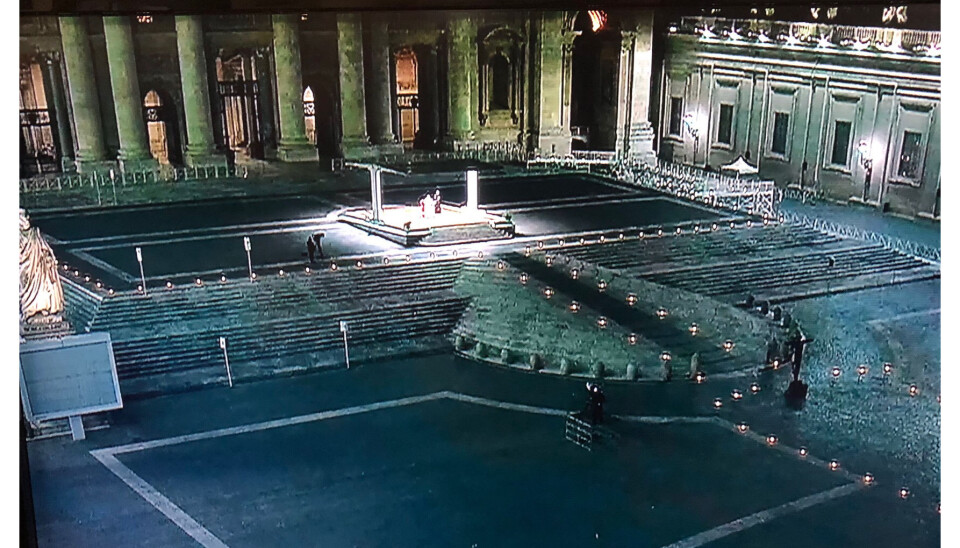
Tempus coronae
(with my gratitude to the wonderful students at IDE2041)
Of all the terrible and weird things that have been going on these interminable days, nothing quite remains with me as much as the televised image of Pope Francis on March 27 dispensing plenary indulgence to the world, alone on Piazza S. Pietro, the silence broken only by the beating rain (drenching the sacred image Salus populi romani which had been extracted for the occasion from its niche in S. Maria Maggiore as protection against this modern plague – apparently, it worked in 1348), and the faint cry of seagulls and ambulance sirens.
On this day, the Pope said the Urbi et orbi, a liturgical blessing reserved for the Bishop of Rome alone, but never before performed outside of Christmas, Easter, or papal elections. The event was thus extraordinary, as might be expected in an extraordinary situation. But here’s where it gets really interesting. The Urbi et orbi is unique in the sense that it is the only liturgical performance that can actually effect across media (according to the Enchiridion indulgentiarum issued by Pope Paul VI). Unlike the Mass, where those “following” the celebration of Mass through the media, theologically speaking, are not “participating”, the Urbi et orbi acts efficiently through a live broadcast so that its audience is eligible to receive its blessing just as those actually physically present at St. Peter’s (in this case only the seagulls).
Now, Pope Francis has, since the lockdown of the churches in Rome at the outbreak of the epidemic, regularly been broadcasting the morning mass from S. Marta in the Vatican, which has been viewed live by increasing numbers. Indeed, the very success of the papal tele-masses caused Francis to caution against a “viralized” Church in one of his homilies, ironically during exactly such a televised morning mass in April. There is a danger, he warned, that the sacrament may decay from real to virtual, from community to individualistic detachment.
So far, all very interesting, but nothing that got me worked up. Until I read this little piece in the Italian newspaper La Repubblica (thanks for the reference, Sheeba!). When some of the finer minds in the Church start commenting on the present situation by quoting Augustine on the question of participation in the liturgy versus attendance to a spectacle, it’s really time to pay attention.
The article raises profound questions about “representation” and prompts an acute question: In the light of VR and computer simulation (much more radically than the Fathers could have ever surmised, reflecting on ancient theatre spectacles), what does actually “being there” entail? What is its ontology, so to speak, and how and in what sense is the experience “embodied” in one case and not in the other? What are the limits between “participation” and “attendance”? I mean, just consider the first person point of view in computer gaming, where simulation and experience are completely (?) blurred in a first person POV…
I believe the church does well to reflect on these distinctions, and to look to patristic and medieval writings, and perhaps there really are real distinctions – but it’s complicated since, as recent Simulation Theory (from Cognitive Science and Philosophy of Mind) suggest, human mental and cognitive processes are all about, precisely, simulation. Theory of Mind (or “folk psychology”, “mind reading”, “mentalizing”) tells us about the human ability to ascribe and make inferences regarding other people’s mental states, intentions, and feelings (cf. Simulation Theory). What’s fascinating is that it seems that this plays a key role in human cognition, in learning and in acculturation.
Of course, part and parcel of patristic and medieval responses like Augustine’s is a deep (Platonic) distrust of representation. But I’m wondering if not mental simulation – that is, inner representation and “imaginative immersion” – was a key process in the medieval liturgy, too. (I have been trying to address some of this, from both a medieval and a modern/cognitive point of view, in my article on Cistercian liturgical sermons in the Acta issue on “Tools for Transformation”.) And, if so, does it not perhaps become hard to uphold clear-cut distinctions between “participation” and “attendance”, between “event” and “performance”?
And, anyway, why is the question of transmedial “representation” less acute in the Urbi et orbi than in the Mass?
And if all this were not enough, a VR pope simulator is just now being launched (thanks for the reference, Karl!), promising a realistic first-person experience of being pope!







